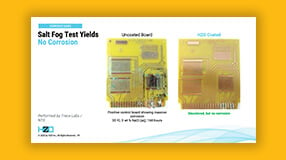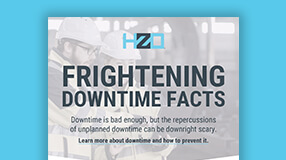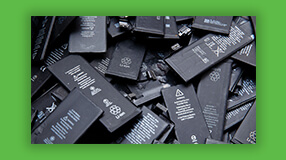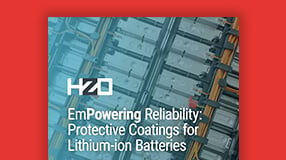INTERNET OF THINGS (IOT)
Robust Protection for IoT Sensors, Delivered with a Cost-Efficient, Scalable Turnkey Solution
Robust Protection for IoT Sensors, Delivered with a Cost-Efficient, Scalable Turnkey Solution
HZO coatings can sustain IoT sensors through full submersion, corrosive and hazardous operating environments at 50% thickness of conventional coatings.
Learn about other markets we serve.
Proven
Tested for over 1,200 hours of continuous submersion
Environment Protection
Superior Moisture Resistance and Corrosion Protection
Ruggedization for Corrosive Environments
HZO's Parylene WVTR and gas permeability properties are extremely low.
| Polymer | Gas Permeability at 25 °C, (cc·mm)/ (m2·day·atm) | WVTR (g·mm)/ (m2·day) |
||||||
| N2 | O2 | CO2 | H2 | H2S | SO2 | CI2 | ||
| Parylene C | 0.4 | 2.8 | 3.0 | 43.3 | 5.1 | 4.3 | 0.1 | 0.08 |
| Parylene N | 3.0 | 15.4 | 84.3 | 212.6 | 313 | 745 | 29.2 | 0.59 |
| Parylene D | 1.8 | 12.6 | 5.1 | - | 0.6 | 1.9 | 0.2 | 0.09 |
| Parylene F (VT-4) | - | 16.7 | - | - | - | - | - | 0.28 |
| Epoxy (ER) | 1.6 | 4 | 3.1 | 43.3 | - | - | - | 0.94 |
| Polyurethane (UR) | 31.5 | 78.7 | 1.81 | - | - | - | - | 0.93 |
| Silicone (SR) | - | 19,685 | 118,110 | 17,717 | - | - | - | - |
Barrier Protection for Resilient Products
Protect IoT components from:
DUST

HUMIDITY

CONDENSATION

OIL


Strong Chemical Resistance
Extremely resistant to solvents and reagents, including those listed below:
ACIDS, BASES, CORROSIVES
ORGANIC SOLVENTS
Hydrochloric acid, 10%
n-Octane
Sulfuric acid, 10%
n-Octane
Nitric acid, 10%
Chlorobenzene
Hydrofluoric acid, 10%
Pyridine
Sodium hydroxide solution, 10%
2-Propanol (IPA)
Ammonium hydroxide solution, 10%
Acetone
Hydrogen peroxide in water (H²O²)
Beneficial Thermal Properties
HZO Coatings:
-
Can protect at temperatures up to 250°C
-
Allow for good heat dissipation

How HZO Coatings Protect IoT - Consistency is Key
Fully Functional Coating at Fraction of the Mass
HZO coatings pass IPC CC-830C test at 50% film thickness of other conformal coatings.
| THICKNESS (MICRONS) | 0.1 TO 5 | 5 TO 12.5 | 12.5 TO 25 | 12.5 TO 50.8 |
|---|---|---|---|---|
| Relevant Standards | UT Type in Upcoming IPC-CC-830C | UT Type in Upcoming IPC-CC-830C | IPC-CC-830B | NASA-STD-8739.1B |
| Protection Level | IPX3 / IPX4 | IPX4 / IPX7 | IPX7 / IPX8 | IPX7 / IPX8 |
| Appropriate Products | Consumer Electronic & MEMS Devices | Consumer & Industrial Electronics | Aerospace, Automotive, Industrial, Medical Device, Telecom, & Other High-Reliability Markets | Aerospace, Defense, & Very Harsh Industrial |
Sustainable Coatings Meet Regulation and Market Claims
ROHS COMPLIANT
REACH COMPLIANT
PROP 65 COMPLIANT
Select HZO Coatings have:
-
No VOCs
-
Biocompatible
-
No Catalysts
-
No Pollution Threats
-
No Cure Time
-
No Solvents
-
Biostable
-
No Halogens
-
No Disposal Issues

Cost-Effective, Scaleable, Convenient Solution
HZO Coating Process

1 Pre-Production
- Inspection for quality standards and control for product tracking.
- Assembly preparation takes place.
- Masking of areas where protection is not needed can be fully automated.
2 Production
- HZO raw material added to vaporizer and sublimated from solid to vapor form.
- Chemical is heated to a high temperature in a pyrolyzer, which "cracks" the raw material into an activated monomer.
- At room temperature in the coating chamber, vapor forms a uniform, thin-film polymer barrier around the PCBs.
Learn more about the CVD process.
3 Post-Production
- De-masking can be manual, semi-automated, or fully automated.

Flexibility and Expertise
-
Use a factory-in-factory business model or outsource to our global locations
-
Coating rework and removal expertise
Cost Savings
-
Masking automation supported by our IP portfolio reduces cost and labor
-
Automated, semi-automated, and manual masking available


Small Batch or Scale to High Volume
-
Throughput can be twice as fast as the industry standard
-
Specially designed equipment decreases turnaround time
Quality
-
Millions of components coated with zero product returns due to coating issues
-
Robust IQC / OQC process pre and post-coating

Download the HZO Parylene Datasheet
Resource Center

Webinar










